英语跆拳道PPT
- 格式:ppt
- 大小:836.50 KB
- 文档页数:9

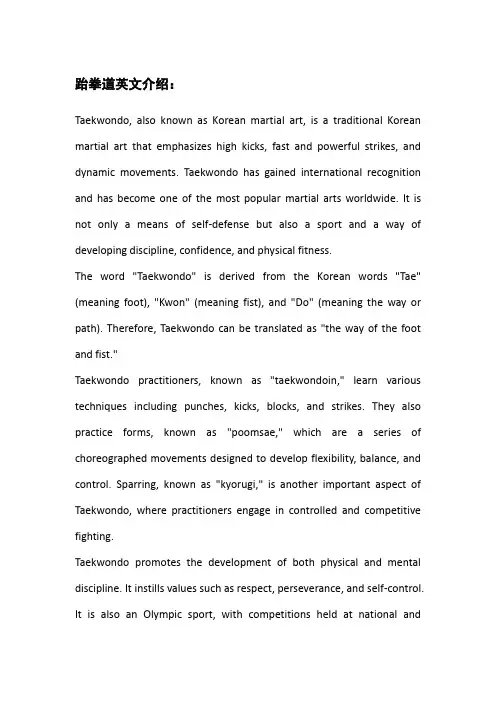
跆拳道英文介绍:Taekwondo, also known as Korean martial art, is a traditional Korean martial art that emphasizes high kicks, fast and powerful strikes, and dynamic movements. Taekwondo has gained international recognition and has become one of the most popular martial arts worldwide. It is not only a means of self-defense but also a sport and a way of developing discipline, confidence, and physical fitness.The word "Taekwondo" is derived from the Korean words "Tae" (meaning foot), "Kwon" (meaning fist), and "Do" (meaning the way or path). Therefore, Taekwondo can be translated as "the way of the foot and fist."Taekwondo practitioners, known as "taekwondoin," learn various techniques including punches, kicks, blocks, and strikes. They also practice forms, known as "poomsae," which are a series of choreographed movements designed to develop flexibility, balance, and control. Sparring, known as "kyorugi," is another important aspect of Taekwondo, where practitioners engage in controlled and competitive fighting.Taekwondo promotes the development of both physical and mental discipline. It instills values such as respect, perseverance, and self-control. It is also an Olympic sport, with competitions held at national andinternational levels.。



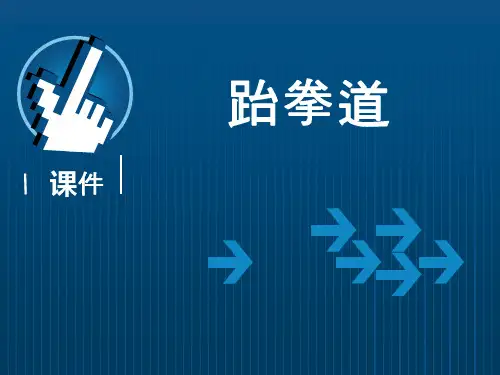
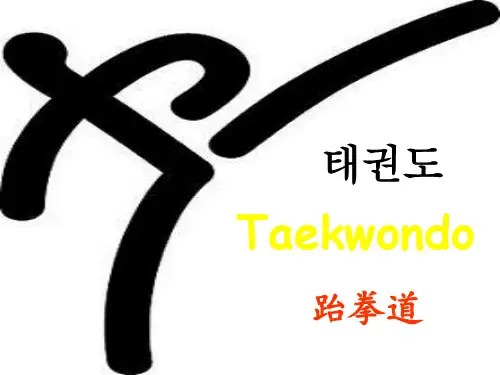
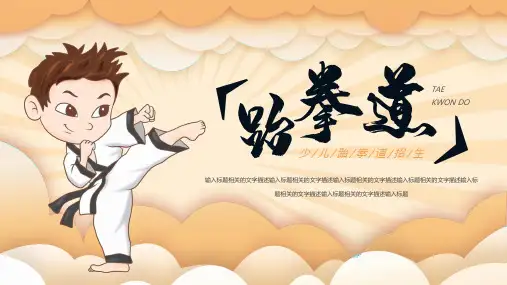
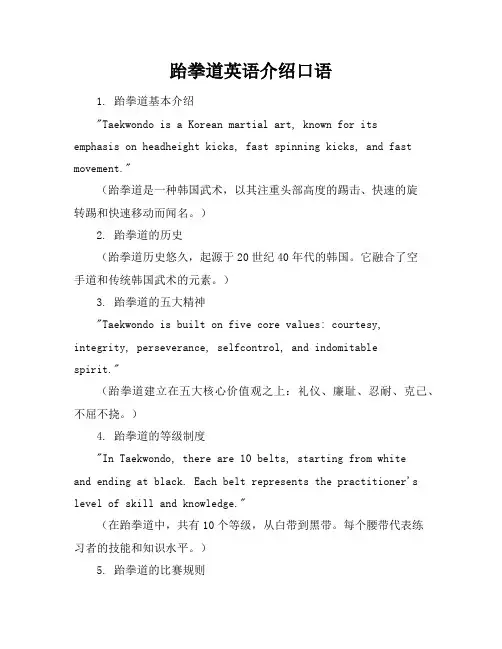
跆拳道英语介绍口语1. 跆拳道基本介绍"Taekwondo is a Korean martial art, known for itsemphasis on headheight kicks, fast spinning kicks, and fast movement."(跆拳道是一种韩国武术,以其注重头部高度的踢击、快速的旋转踢和快速移动而闻名。
)2. 跆拳道的历史(跆拳道历史悠久,起源于20世纪40年代的韩国。
它融合了空手道和传统韩国武术的元素。
)3. 跆拳道的五大精神"Taekwondo is built on five core values: courtesy, integrity, perseverance, selfcontrol, and indomitablespirit."(跆拳道建立在五大核心价值观之上:礼仪、廉耻、忍耐、克己、不屈不挠。
)4. 跆拳道的等级制度"In Taekwondo, there are 10 belts, starting from whiteand ending at black. Each belt represents the practitioner's level of skill and knowledge."(在跆拳道中,共有10个等级,从白带到黑带。
每个腰带代表练习者的技能和知识水平。
)5. 跆拳道的比赛规则(跆拳道比赛包括对打和套路演示。
准确有力的踢击和拳击会获得分数。
)跆拳道英语介绍口语(续)6. 加入跆拳道课程"If you're interested in joining a Taekwondo class, you can say, 'I'd like to enroll in your Taekwondo program. What are the class times?'"(如果你对加入跆拳道课程感兴趣,你可以说:“我想参加你们的跆拳道课程。
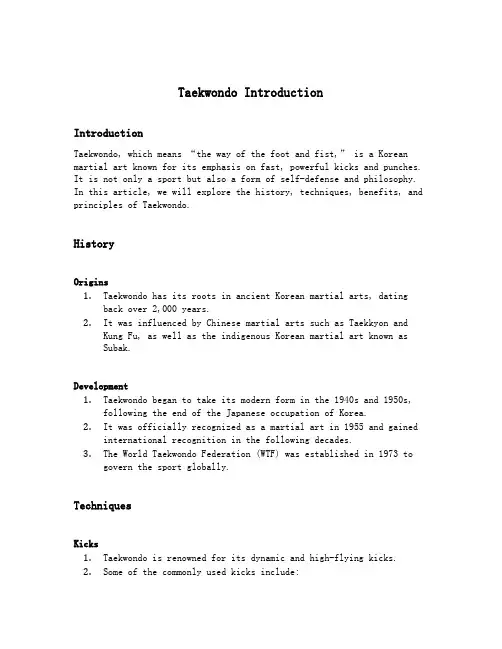
Taekwondo IntroductionIntroductionTaekwondo, which means “the way of the foot and fist,” is a Korean martial art known for its emphasis on fast, powerful kicks and punches. It is not only a sport but also a form of self-defense and philosophy. In this article, we will explore the history, techniques, benefits, and principles of Taekwondo.HistoryOrigins1.Taekwondo has its roots in ancient Korean martial arts, datingback over 2,000 years.2.It was influenced by Chinese martial arts such as Taekkyon andKung Fu, as well as the indigenous Korean martial art known asSubak.Development1.Taekwondo began to take its modern form in the 1940s and 1950s,following the end of the Japanese occupation of Korea.2.It was officially recognized as a martial art in 1955 and gainedinternational recognition in the following decades.3.The World Taekwondo Federation (WTF) was established in 1973 togovern the sport globally.TechniquesKicks1.Taekwondo is renowned for its dynamic and high-flying kicks.2.Some of the commonly used kicks include:–Front kick–Roundhouse kick–Sidekick–Hook kick–Axe kickStrikes1.Taekwondo practitioners also utilize various hand strikes for bothoffensive and defensive purposes.2.Some of the striking techniques include:–Punches–Knifehand strikes–Elbow strikesForms (Poomsae)1.Taekwondo forms, known as poomsae, are a series of predeterminedmovements that simulate combat scenarios.2.Practicing forms helps improve technique, balance, and focus.Sparring1.Taekwondo sparring, known as kyorugi, involves controlled full-contact combat between two practitioners.2.The objective is to score points by executing precise kicks andpunches on the opponent’s scoring areas.Benefits of Taekwondo1.Physical Fitness:–Taekwondo is a highly demanding sport that improvescardiovascular fitness and muscular strength.–Continuous practice enhances flexibility, agility, and coordination.2.Self-Defense:–Taekwondo equips individuals with effective self-defense techniques, teaching them to defend themselves againstpotential threats.3.Mental Discipline:–Taekwondo emphasizes discipline and self-control, fostering mental strength and resilience.–Practitioners learn to focus their minds, developconcentration, and overcome challenges.4.Self-Confidence:–Training in Taekwondo builds self-confidence and self-esteem.–Achieving new belt ranks and mastering techniques instills a sense of accomplishment and boosts self-confidence.Principles of TaekwondoCourtesy (Ye Ui)1.Taekwondo emphasizes showing respect for oneself and others.2.Practitioners are taught to bow to instructors and fellow studentsas a sign of respect.Integrity (Yom Chi)1.Practitioners are encouraged to be honest and have strong moralprinciples.2.Upholding integrity is fundamental to the practice of Taekwondo.Perseverance (In Nae)1.Taekwondo teaches the value of perseverance and determination.2.Practitioners learn to overcome obstacles and setbacks, both intraining and in life.Self-Control (Guk Gi)1.Practicing self-control is crucial in Taekwondo.2.It involves mastering emotions, maintaining calmness even inchallenging situations, and avoiding unnecessary violence.Indomitable Spirit (Baekjul Boolgool)1.Taekwondo promotes an indomitable spirit, encouragingpractitioners to never give up.2.It instills mental toughness and the ability to face adversitywith courage and determination.Taekwondo is more than just a sport or a martial art. It is a way of life that encompasses physical, mental, and moral aspects. Through its techniques, principles, and philosophy, Taekwondo aims to develop well-rounded individuals who can achieve self-improvement and contribute positively to society.。
